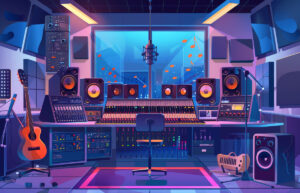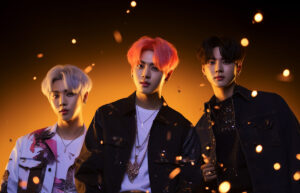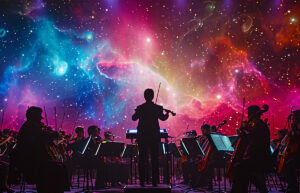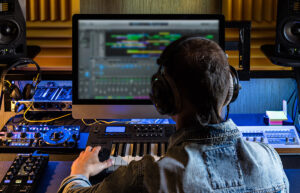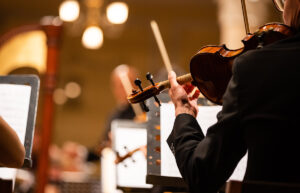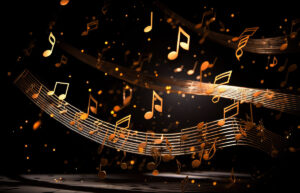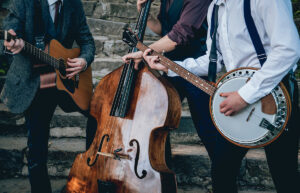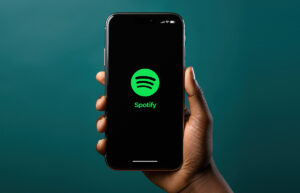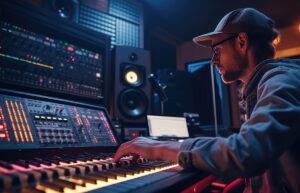How To Make A Music Video: Steps, Tips & Iconic Music Videos

Learn the essentials of making outstanding music videos. From detailing the history of music videos to mastering the art of video creation, this blog unfolds the essence, importance, popularity, and step-by-step guide to craft a visual symphony. Delve into expert-guided tips for professionally editing videos and explore iconic examples that have become viral and gained internet popularity. Whether you’re an aspiring creator or a music enthusiast, this guide can help you uncover the secrets of bringing sound to life through captivating visuals.
Welcome to TheDemoStop, now join the community!
Connect with artists, fans and producers around the world.
What is a music video?
A music video is a visual depiction of a song, typically combining imagery, storytelling, and artistic elements to complement and enhance auditory experience. A music video is a harmonious marriage of music and film, providing viewers with an immersive and engaging way of experiencing and interpreting the song. Music videos can range from simple performances to elaborate cinematic productions, offering diverse creative expression for artists.
History of music videos
The history of music videos is fascinating and closely tied to the evolution of music and visual media. Key milestones in the evolution of music are as follows:
- Pre-MTV era (Pre-1981): Before Music Television (MTV) launched in 1981, music videos were primarily produced by artists and record labels. They were often simple and low-budget, featuring artists lip-syncing or performing with simple backdrops.
- Emergence of MTV (1981): MTV revolutionized the music industry by introducing a 24-hour channel playing music videos. “Video Killed the Radio Star” by The Buggles was the first song played on MTV. This marked a shift in music marketing and consumption.
- Golden age of MTV (1980s): The 1980s saw iconic music videos’ rise and directors’ emergence as creative forces. Artists like Michael Jackson, Madonna, and Duran Duran produced visually stunning videos that became cultural phenomena. Jackson’s “Thriller” (1983), directed by John Landis, is particularly notable for its cinematic quality.
- Crossing boundaries (late 1980s–early 1990s): With advancement in technology, music videos became elaborate and experimental. Directors such as Spike Jonze and Michel Gondry imbued unique storytelling and visual techniques to videos. Hip-hop artists embraced the medium, creating memorable videos that reflected upbeat culture.
- Total Request Live (TRL) and the digital age (late 1990s–early 2000s): TRL on MTV became a popular platform for showcasing music videos, and the late 90s witnessed a surge in big-budget productions. The rise of the internet and digital media allowed for easy distribution and sharing of music videos.
- YouTube and online platforms (mid-2000s–present): The 2000s saw a decline in the traditional dominance of TV channels for music videos. YouTube, launched in 2005, became a major platform for artists to share their videos directly with global audiences. The accessibility of video creation tools also led to a democratization of music video production.
- Visual albums and short films (2010s–present): Artists such as Beyoncé and Kendrick Lamar began releasing visual albums and extended music videos, blurring the lines between music videos and short films. Such projects often tell a cohesive story and provide a more immersive experience.
- Virtual and augmented reality (current trends): With advancements in technology, artists are exploring virtual reality (VR) and augmented reality (AR) in music videos, offering audiences interactive and immersive experiences.
Importance of music videos
Visual storytelling
- Enhanced narrative: Music videos provide an additional layer of storytelling to the song. They allow artists to convey emotions, themes, and messages visually, complementing the lyrics and melody.
- Cohesive concepts: Directors often collaborate with artists to create a visual vision that aligns with the song’s narrative, resulting in an immersive and memorable experience.
Marketing and promotion
- Brand building: Music videos contribute significantly to an artist’s brand identity. Iconic visuals become synonymous with the artist’s style and can influence public perception.
- Wider reach: With the advent of online platforms such as YouTube, music videos have a global reach, enabling artists to connect with diverse audiences and gain international recognition.
Cultural impact
- Trends and fashion: Music videos often set fashion, dance, and aesthetics trends. Iconic looks from videos can influence popular culture and even impact fashion trends.
- Cultural commentary: Some music videos serve as social or cultural commentary, addressing relevant issues and sparking discussions beyond music.
Welcome to TheDemoStop, now join the community!
Connect with artists, fans and producers around the world.
Artistic expression
- Creative collaboration: Music videos allow artists to collaborate with directors, cinematographers, and visual artists, fostering creativity and pushing the boundaries of artistic expression.
- Experimentation: The visual medium provides a platform for experimentation, allowing artists to explore innovative visual techniques, special effects, and cinematic storytelling.
Audience engagement
- Fan connection: Music videos offer fans a deeper connection to their favorite artists. Fans often anticipate and engage with new releases, contributing to the overall fan experience.
- Social media impact: Clips and screenshots from music videos are widely shared on social media platforms, creating buzz and extending the artist’s reach further.
Monetization and revenue
- Streaming platforms: Music videos contribute to an artist’s presence on streaming platforms, generating revenue. Advertisements and partnerships on video-sharing media also contribute to an artist’s income.
- Merchandising opportunities: Iconic visuals from music videos can be leveraged for merchandise, creating additional revenue streams.
Technological advancements
- Virtual and augmented reality: With advancement in technology, VR and AR can be augmented in music videos, providing audiences with immersive and interactive experiences. This showcases the industry’s adaptability to technological advancements.
Evolution of the art form
- Historical documentation: Music videos document the evolution of visual and musical styles over time. They serve as a historical archive, reflecting different eras’ cultural and technological landscape.
- Genre fusion: Blending music and visuals allows genre fusion, breaking traditional boundaries and appealing to a diverse audience.
Popularity of music videos in today’s world
The following factors influence the popularity of a music video:
Online platforms and accessibility
- YouTube dominance: YouTube, launched in 2005, has become a central platform for music videos. Its accessibility has democratized the distribution of videos, allowing both established and emerging artists to reach a global audience.
- Streaming services: Major streaming services like Spotify, Apple Music, and Tidal incorporate music videos into their platforms, making them easily accessible to users alongside audio tracks.
Social media integration:
- Sharing culture: Social media platforms such as Instagram, X, and Facebook facilitate the rapid sharing of music videos. Clips and snippets often go viral, contributing to the song’s and artist’s overall popularity.
- Short-form videos: Platforms such as TikTok and Reels have popularized music videos through short-form, user-generated content. Songs gain immense traction when users create and share dance challenges or creative content related to the music video.
Visual appeal and engagement:
- Visual-first culture: In an era of visual content consumption, music videos align with the preferences of a visual-first culture. Audiences are drawn to engaging and visually stunning content, making music videos a preferred form of entertainment.
- Fan interaction: Artists and record labels actively engage with fans through behind-the-scenes content, teasers, and interactive elements, fostering community around the music video.
Cross-platform integration
- Multimedia experiences: Music videos extend beyond YouTube to other platforms, including official artist websites, mobile apps, and virtual reality experiences. This cross-platform integration enhances overall viewing experience.
- Collaborations with brands: Artists collaborate with brands for music video releases, leveraging the promotional power of both the artist and the brand. This synergy contributes to the popularity of the video.
Globalization and cultural exchange
- Diverse representation: Music videos showcase diverse cultures, styles, and perspectives. This diversity resonates with a global audience, fostering cultural exchange and allowing viewers to explore different musical genres and visual aesthetics.
- International collaboration: Global collaborations between artists from different countries have become more common in music videos, contributing to a sense of interconnectedness in the global music scene.
Technological advancements
- VR and AR experiences: Artists explore virtual reality (VR) and augmented reality (AR) to create immersive music video experiences. Adopting advanced technology keeps the format fresh and appeals to tech-savvy audiences.
Revenue generation
- Monetization opportunities: Music videos generate revenue through advertising on platforms like YouTube. Additionally, they promote merchandise, concert tours, and other income streams for artists.
Artist autonomy and creativity
- Creative expression: Artists have more autonomy in shaping their visual narratives, leading to various innovative and experimental music videos that capture audience attention and contribute to an artist’s distinct identity.
Welcome to TheDemoStop, now join the community!
Connect with artists, fans and producers around the world.
A step-by-step guide on how to create a music video
Step 1: Develop the concept
- Understand the song: Analyze the song’s lyrics, mood, and theme. The video should complement and enhance the message conveyed by the music.
- Create a visual narrative: Develop a storyline or concept that aligns with the emotions and story of the song. Consider the genre and style of the music when crafting your idea.
Step 2: Know your audience
- Target demographics: Identify the primary audience for the music video, including factors like age, cultural background, and interests. Tailor the video to resonate with this specific audience.
Step 3: Casting the film crew and getting equipment
- Hire a director: Choose a director who understands your vision and has experience in music video production.
- Assemble a film crew: Depending on the scale of the project, hire professionals for roles such as cinematography, lighting, and editing.
- Secure equipment: Ensure you have cameras, lighting equipment, and editing tools. The quality of equipment contributes to the overall production value.
Step 4: Storyboarding
- Visual blueprint: Create a storyboard to outline the sequence of shots in the video. This visual blueprint is for the director, cinematographer, and crew members.
- Sequence shots: Plan how each shot will transition to the next considering the narrative flow and the song’s pacing.
Consider your budget
- Budget allocation: Allocate resources based on your budget. Consider expenses such as location fees, equipment rental, and crew salaries.
- Prioritize spending: Identify key elements that require higher investment, such as special effects or unique locations.
Location scouting based on your storyboard
- Match locations to concept: Scout locations that align with the visual concept. Consider the mood, setting, and atmosphere required for each scene.
- Permits and permissions: Ensure you have the necessary permits for filming in chosen locations.
Choosing the right song
- Relevance to the concept: Ensure the selected song complements the video concept and enhances the storytelling.
- Legal considerations: Obtain the rights and permissions to use the music in your video.
Filming
- Capture live footage:
- Coordinate with the director and cinematographer to execute the shots according to the storyboard.
- Direct the actors and ensure they convey the desired emotions.
- Adjust lighting, framing, and camera movement to enhance visual appeal.
- Using stock footage:
- Integrate stock footage if it improves or supplements the narrative. Ensure it seamlessly matches the overall visual style.
Being creative
- Visual innovation: Experiment with creative techniques, such as unique camera angles, visual effects, or unconventional storytelling methods.
- Artistic expression: The music video expresses creativity and showcases the artist’s unique style.
Use the music
- Sync with the beat: Ensure that visuals synchronize with the music’s rhythm and beats, enhancing the video’s impact.
Key takeaways
- Consistency: Maintain consistency in the video’s visual style, color palette, and overall aesthetic.
- Review and refine: Regularly review the footage to identify areas for improvement. Make necessary adjustments during the filming and editing process.
Finally – share it with your fanbase
- Strategic release: Plan a strategic release date for the music video. Consider the song’s release date, promotional events, and audience engagement trends.
- Social media promotion: Leverage social media platforms to promote the video. Share teasers of behind-the-scenes content and engage with fans to build anticipation.
Welcome to TheDemoStop, now join the community!
Connect with artists, fans and producers around the world.
Promotion of the music video
Why is music video promotion important?
Music video promotion is crucial for several reasons, playing a pivotal role in the success of an artist’s work. First, promotion is a powerful marketing tool, amplifying the reach and visibility of the music video. In today’s digital age dominated by online platforms, promotion ensures that the video is strategically placed on platforms like YouTube, where millions of potential viewers can discover it. This move increases the artist’s fan base and enhances brand recognition.
Additionally, promotion facilitates engagement with the audience through social media, creating a buzz and anticipation around the video’s release. Successful promotion can lead to viral moments, trending topics, and increased shares, contributing to the video’s cultural impact and, ultimately, the artist’s success in a competitive music landscape.
How to promote a music video?
Build hype
Creating anticipation of the music video is essential for a successful promotion strategy. Start by teasing snippets or behind-the-scenes content on social media platforms. Use countdowns, exclusive previews, and engaging captions to build excitement. Encourage your fanbase to share and participate in the buildup, creating a sense of community and anticipation.
Share on social media
Social media platforms are powerful tools for promoting music videos. Share the video across all relevant channels, including Instagram, Facebook, X, and TikTok. Craft eye-catching visuals, such as custom thumbnails and teaser posters, to accompany your posts. Leverage popular hashtags and engage with your audience through comments and direct messages to foster a sense of connection.
Contact influencers
Identify influencers in the music and entertainment niche whose audience aligns with yours. Reach out to them to share your music video through collaborations or by requesting them to feature it on their platforms. Influencers can significantly amplify your reach, tapping into their established audience and introducing your music to new potential fans.
Email blast
Use your mailing list to reach out to your existing fan base directly. Craft an engaging and personalized email blast with details about the music video, its release date, and a call-to-action encouraging recipients to share it. Offering exclusive content or behind-the-scenes insights to your email subscribers can incentivize them to participate in the promotion actively.
Paid ads
Consider investing in targeted paid advertising to reach a broader audience. Facebook, Instagram, and YouTube offer diverse advertising options. To maximize the impact of these promotion campaigns, tailor your ads to specific demographics, interests, and geographical locations. Budget allocation should be strategic, focusing on peak times and audiences likely to engage with your content.
Music gateway
Explore platforms like Music Gateway, which connects artists with industry professionals, sync opportunities, and promotional services. Submit your music video to relevant opportunities on these platforms to increase its chances of being featured in various media outlets, playlists, or film and television.
Tips on improving the music video
Use plenty of light
Proper lighting is fundamental to creating a visually appealing music video. Ensure that the recording environment is well-lit to highlight the performers and details of the scene. Natural light or strategically placed artificial lighting can enhance the visual quality, ensuring every frame is clear and vibrant. Adequate lighting improves the overall aesthetics and contributes to a professional and polished look.
Record in a quiet location
Choose a recording location with minimal background noise to capture clean audio. Background noise, even subtle ambient sounds, can distract from the music and diminish the overall quality of the video. Opt for a controlled environment where you can manage and minimize extraneous sounds during the recording process.
Avoid echo
Echo can negatively impact the clarity of your audio. Choose a recording space with minimal reverberation to prevent echo or consider using soundproofing techniques. Eliminating echo ensures that the vocals and instruments are captured precisely, allowing for a more immersive and enjoyable viewing experience.
Hire a professional sound engineer.
Enlist the expertise of a professional sound engineer to handle the audio recording and mixing. A skilled sound engineer understands the nuances of capturing high-quality audio and can optimize the sound to complement the visual elements of the music video. Their expertise contributes significantly to the overall audiovisual experience.
Prioritize crisp, clear audio
Clear and crisp audio is essential in a music video. Invest in high-quality microphones and recording equipment to capture the depth of vocals and instruments. Pay close attention to audio levels during editing, eliminating distortions or inconsistencies. A well-balanced audio mix enhances the impact of the music video.
Avoid shaky footage
Stabilize your camera to avoid shaky footage, which can be distracting and detract from the professionalism of the video. Use tripods or stabilizers to achieve smooth and steady shots. Consistent and stable footage allows the audience to focus on the performance and visual elements without unnecessary distractions.
Properly set your gain
Setting the gain correctly is crucial for capturing clean and distortion-free audio. Adjust the gain on your recording equipment to ensure the audio levels are neither too low nor too high. Proper gain settings contribute to a balanced and professional audio recording.
Edit Your footage correctly
In the editing phase, you combine all elements to create a cohesive and polished music video. Pay attention to the pacing, transitions, and visual effects. Trim unnecessary footage, synchronize audio and video seamlessly, and incorporate creative editing techniques that enhance the storytelling aspect of the video. Thoughtful editing elevates the overall quality of the final product.
Welcome to TheDemoStop, now join the community!
Connect with artists, fans and producers around the world.
Iconic music videos
“Life on Mars?” by David Bowie
- Visual innovation: Released in 1973, “Life on Mars?” is renowned for its visual innovation. An evolved artist, Bowie created a surreal and artistic video that matched the song’s eclectic nature.
- Symbolism: The video incorporates symbolic imagery and references to art, cinema, and pop culture. It reflects Bowie’s ability to blend various influences into a cohesive visual narrative.
- Artistic collaboration: The collaboration with director Mick Rock was crucial in shaping the video’s unique style. The visuals are evidence of Bowie’s commitment to pushing artistic boundaries.
“Thriller” by Michael Jackson
- Cinematic quality: Directed by John Landis, “Thriller” (1983) is a landmark in music video history. Its cinematic quality and narrative structure transformed music videos into mini-movies.
- Choreography: The iconic dance sequence, choreographed by Michael Jackson and Michael Peters, became a cultural phenomenon. The “Thriller” dance remains one of the world’s most recognizable and imitated routines.
- Narrative impact: With its horror-themed narrative, “Thriller” expanded the possibilities of what a music video could convey, creating an enduring legacy in popular culture.
“When Doves Cry” by Prince
- Minimalism: Released in 1984, the video for “When Doves Cry” is notable for its minimalism. Prince’s decision to eschew a traditional narrative allowed the focus to remain on the song’s emotional intensity.
- Artistic expression: Prince’s creative expression shines through, showcasing his ability to convey raw emotion through subtle yet powerful visual elements. The video aligns with Prince’s reputation as a boundary-pushing and enigmatic artist.
- Symbolic imagery: Symbolic imagery, including doves and water, adds depth to the video’s interpretation, inviting viewers to delve into its layers of meaning.
“I Wanna Dance With Somebody” by Whitney Houston
- Colorful aesthetics: Whitney Houston’s 1987 video for “I Wanna Dance With Somebody” is celebrated for its vibrant and colorful aesthetics. The energetic visuals match the upbeat and danceable nature of the song.
- Fashion and style: The video captures the 1980s fashion and style, reflecting the era’s exuberance. Whitney’s glamorous looks and the dynamic choreography contribute to the video’s infectious energy.
- Global appeal: The video’s universal theme of the joy of dancing and celebrating love resonated globally, making it an iconic representation of 80s pop culture.
“Like a Prayer” by Madonna
- Controversy and social commentary: Madonna’s “Like a Prayer” (1989) stirred controversy with its provocative imagery overlapping religious themes. The video delves into social issues, combining religious iconography with racial tension, sparking discussions on artistic freedom and societal norms.
- Narrative complexity: Directed by Mary Lambert, the video weaves a complex narrative, blurring the lines between fantasy and reality. Madonna’s ability to convey a compelling story through visuals is evident, adding layers of interpretation to the song.
- Impact on pop culture: “Like a Prayer” remains a defining moment in Madonna’s career, showcasing her as an artist unafraid to address controversial subjects and challenge societal norms through her work.
Summary
What is a music video?
A music video visually represents a song, combining music with images or a storyline to enhance the overall artistic and entertainment experience.
History of music videos
- Pre-1981: Basic promotional videos created for artists aired on television.
- 1981: MTV launched, transforming music videos into a major industry.
- 1980s: Rise of iconic videos by artists like Micheal Jackson and Madonna.
- 1990s: Expansion of creativity, experimentation with visuals and storytelling.
- 2000s: The digital era sees online platforms like YouTube dominating video distribution.
- Present: Music videos remain vital for artists, with online platforms offering global reach and diverse creative opportunities.
Importance of music videos
- Visual promotion: Enhances marketing and visibility.
- Artistic expression: Allows creativity beyond audio.
- Global reach: Connects with diverse audiences online.
- Brand building: Establishes and reinforces artist identity.
- Engagement: Provides an immersive experience for fans.
Welcome to TheDemoStop, now join the community!
Connect with artists, fans and producers around the world.
Popularity of music videos in today’s world
- Digital dominance: Thriving on online platforms like YouTube and Spotify.
- Visual appeal: Enhances music enjoyment with visuals.
- Social media impact: Shared with the masses, creating buzz and trends.
- Global accessibility: Connects artists with a diverse,global audience.
- Creative expansion: Artists showcase their creativity in these videos.
Steps to create a music video
- Develop concept: Create a compelling visualization concept that aligns with your song.
- Know your audience: Understand your target audience to tailor the video for maximum impact.
- Casting and equipment: Assemble a skilled film crew and secure necessary equipment.
- Storyboarding: Draft the shots as a guide to the filming process.
- Consider budget: Allocate resources strategically based on your budget.
- Location scouting: Select locations aligning with your storyboard.
- Choose the right song: Ensure the song complements the video concept.
- Filming: Consider lighting and stability when recording live video.
- Use stock footage: Integrate stock footage where that enhances the narrative.
- Be creative: Experiment with visuals, effects and storytelling techniques.
- Use the music: Sync visuals with the music to improve the overall experience.
- Key takeaways: For coherence and quality, edit and brush up the video.
- Share with fanbase: Strategically release and promote the video on platforms to engage with your fanbase.
Promotion of music videos
- Why is music video promotion important?
Promoting music videos is like increasing the volume of an artist’s presence. It’s a way to reach a broader audience, build anticipation, and create a lasting impression. Promotion drives views, increases engagement, and boosts an artist’s visibility in a saturated market.
- How to promote music videos?
- Build hype
- Share on social media
- Contact influencers
- Email blast
- Paid ads
- Music gateway
Tips on improving the music video
- Use plenty of light: Ensure well-lit scenes for visual clarity.
- Quiet location: Record in a noise-controlled environment.
- Avoid echo: Choose locations with minimal reverberation.
- Professional sound engineer: Hire an expert for high quality audio.
- Crisp, clear audio: Prioritize well-mixed and clear audio.
- Avoid shaky footage: Use stabilizers to maintain stable shots.
- Proper gain settings: Set gain levels correctly for distortion-free audio.
- Edit correctly: Precisely edit for coherence and visually appealing results.
Iconic music videos
- “Life on Mars?,” David Bowie
- “Thriller,” Michael Jackson
- “When Doves Cry,” Prince
- “I Wanna Dance With Somebody,” Whitney Houston
- “Like a Prayer,” Madonna
FAQs
How do you make a music video step by step?
- Content development: Develop a clear concept aligning with the song’s theme
- Pre-production: Plan logistics, create a budget, and gather necessary equipment.
- Casting and crew: Hire a director, crew and cast that align with your vision.
- Location scouting: Choose suitable locations based on the storyboard.
- Recording: Capture live footage with proper lighting and stable shorts.
- Editing: Edit the footage for coherence, pacing and visual appeal.
- Audio mixing: Ensure crisp, clean audio that complements the visuals.
- Final review: Review and refine the video before release.
- Promotion: Share on social media, collaborate with influencers, and leverage online platforms for promotion.
Why are music videos still popular?
Music videos are endearing because they offer a visually immersive experience for audiences to connect with music. With the digitalization era, online platforms like YouTube make online videos easily accessible, providing artists with a dynamic tool for self-expression and brand building. The visual appeal enhances the music experience, making music videos vital to an artist’s promotional and artistic strategy.
Why are music videos important in today's music industry?
Music videos are crucial in today’s music industry as they are powerful marketing tools and enhance the artist brand to promote sales of musical recordings. Music videos also act as a bridge between the artist and the fans, fostering greater engagement and connection with the audience.
Why are music videos important for the audience?
Music videos are like a two-way stream. Through the visuals, not only does the artist attempt to connect with the listeners, but listeners establish a connection with the artist. Music videos add a visual dimension to the auditory experience, enhancing the song’s meaning and allowing artists to showcase creativity. They create lasting memories, deepen the connection between artists and fans, and turn a piece into a multi-sensory experience.
What percentage of people watch music videos?
According to research by Statista, 48.9% of the world’s population watch music videos.
How do you promote music videos?
- PR and press releases: Reach out to music blogs, magazines and websites for features and reviews to generate buzz.
- Live performances: Incorporate snippets of the video into live performances or virtual concerts to connect with audiences in real time.
- Contests and giveaways: Create excitement by organizing games where fans can participate and win exclusive rewards tied to the music video.
- Streaming platforms promotion: Coordinare with streaming platforms to feature your video, do playlist placements, and leverage their promotional tools.
- Engage with fans: Respond to comments, create challenges, or encourage user-generated content related to the music video.
How to make a music video look professional?
- High-quality equipment: Use professional cameras and audio equipment.
- Storyboarding: Plan shots and sequences in advance for a cohesive narrative.
- Artistic direction: Develop a clear concept and storyboard for visual coherence.
- Attention to detail: Pay attention to framing, composition, and overall visual aesthetics.
- Effective color grading: Enhance visual appeal through thoughtful color grading.
- Collaborate with professionals: Involve experienced directors, cinematographers and sound engineers.
Why is it important to promote music videos?
Promoting music videos is like shouting from the rooftops about your creative masterpiece. It’s not just about getting views; it’s an essential marketing tool. Videos can go viral, expanding an artist’s reach and fan base. They create buzz, drive streaming and download numbers, and help establish an artist’s brand.
How to promote music videos in easy steps?
- Social media buzz: Tease the video on platforms like Instagram, X and Fb.
- Email newsletter: Send out a newsletter to your email subscribers with video details and a call to action.
- YouTube optimization: Optimize your video title, description, and tags for better search visibility on YouTube.
- Fan engagement: Encourage fans to share, comment, and engage with the video on social media.
- Behind-the-scenes content: Share glimpses to humanize the process and connect with the audience.


